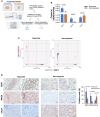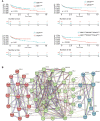EBF1, MYO6 and CALR expression levels predict therapeutic response in diffuse large B-cell lymphomas
- PMID: 38035116
- PMCID: PMC10682075
- DOI: 10.3389/fimmu.2023.1266265
EBF1, MYO6 and CALR expression levels predict therapeutic response in diffuse large B-cell lymphomas
Abstract
Background: Diffuse large B-cell lymphoma (DLBCL) is a hematological malignancy representing one-third of non-Hodgkin's lymphoma cases. Notwithstanding immunotherapy in combination with chemotherapy (R-CHOP) is an effective therapeutic approach for DLBCL, a subset of patients encounters treatment resistance, leading to low survival rates. Thus, there is an urgent need to identify predictive biomarkers for DLBCL including the elderly population, which represents the fastest-growing segment of the population in Western countries.
Methods: Gene expression profiles of n=414 DLBCL biopsies were retrieved from the public dataset GSE10846. Differentially expressed genes (DEGs) (fold change >1.4, p-value <0.05, n=387) have been clustered in responder and non-responder patient cohorts. An enrichment analysis has been performed on the top 30 up-regulated genes of responder and non-responder patients to identify the signatures involved in gene ontology (MSigDB). The more significantly up-regulated DEGs have been validated in our independent collection of formalin-fixed paraffin-embedded (FFPE) biopsy samples of elderly DLBCL patients, treated with R-CHOP as first-line therapy.
Results: From the analysis of two independent cohorts of DLBCL patients emerged a gene signature able to predict the response to R-CHOP therapy. In detail, expression levels of EBF1, MYO6, CALR are associated with a significant worse overall survival.
Conclusions: These results pave the way for a novel characterization of DLBCL biomarkers, aiding the stratification of responder versus non-responder patients.
Keywords: R-CHOP; biomarkers of response; diffuse large B-cell lymphoma; elderly patients; gene expression signature; therapy resistance.
Copyright © 2023 Turdo, Gaggianesi, D’Accardo, Porcelli, Bella, Cricchio, Pillitteri, Porcasi, Lo Iacono, Verona, Modica, Roozafzay, Florena, Stassi, Mancuso and Todaro.
Conflict of interest statement
The authors declare that the research was conducted in the absence of any commercial or financial relationships that could be construed as a potential conflict of interest. The author(s) declared that they were an editorial board member of Frontiers, at the time of submission. This had no impact on the peer review process and the final decision.
Figures




References
-
- Hounsome L, Eyre TA, Ireland R, Hodson A, Walewska R, Ardeshna K, et al. Diffuse large B cell lymphoma (DLBCL) in patients older than 65 years: analysis of 3 year Real World data of practice patterns and outcomes in England. Br J Cancer (2022) 126(1):134–43. doi: 10.1038/s41416-021-01525-4 - DOI - PMC - PubMed
Publication types
MeSH terms
Substances
LinkOut - more resources
Full Text Sources
Research Materials
Miscellaneous

